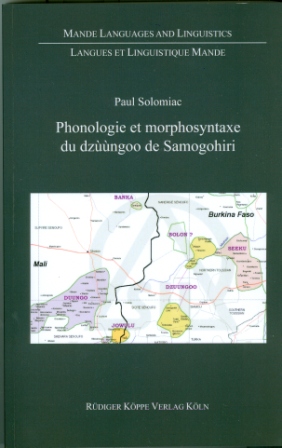


Spoken by less than 20,000 speakers living by the Malian border of Burkina Faso, Dzùùngoo (also called Samogho) is a North West Mande language of the Niger Congo family. The term Samogho descends from Bambara and describes the language as well as different ethnic groups in Burkina Faso and Mali. Samogohiri is one of the disctricts (départements) in Burkina Faso, located in the region Hauts-Bassins, in the province Kénédougou.
This language has not yet been the object of a detailed linguistic description. Thus, based on extensive lexical, textual and audio data recorded in Samogohiri over a period of 20 years, we propose to provide the scientific community a descriptive foundation for the future development of a bilingual Dzùùngoo–French dictionary that should acknowledge the world cultural heritage that this endangered language represents.
The initial issues for this work are therefore lexical. The internal structure of the lexeme is outlined in the phonological description where the inventory of phonemes (Chapter 3), the syllabic structure of the word (Chapters 2, 4 & 5) and its tonal structure (Chapter 6) are developed. The morphosyntactic description as such mainly focuses on defining and establishing the different grammatical categories to which every lexical item belongs (Chapter 9). The syntactic organization of the sentence is then considered in the presentation of the different nominal (Chapter 10) and verbal (Chapter 11) operations, as well as different predication structures, non verbal (Chapter 12) and verbal (Chapter 13), marked structures (Chapter 14) and complex structures (Chapter 15).
Using a typological and functional approach, this description is an attempt to put Dzùùngoo morphosyntax in the global perspective of Mande linguistics.
Under the links below, you will find the complete text of a review by Klaudia Dombrowsky-Hahn.
DESCRIPTION EN FRANÇAIS
La présente description morphosyntaxique représente une version abrégée d’un travail de thèse soutenue en novembre 2007. Y sont inclus une description des principaux traits phonologiques segmentaux et suprasegmentaux ainsi qu’une description des principaux traits de la morphosyntaxe de la langue dzùùngoo aussi appelée samogho.
Les données empiriques ayant été recueillies auprès de résidents de la ville de Samogohiri au sud-ouest du Burkina Faso. Le système ici décrit correspond plus particulièrement à celui du dialecte de cette ville (6.264 habitants). – Samogohiri est, en même temps, un département du Burkina Faso située dans la province de Kénédougou et dans la région des Hauts-Bassins.
Le dzùùngoo appartient à la grande famille des langues Niger-Congo, et plus particulièrement à la branche nord-ouest du groupe mandé. Le terme samogho vient du bambara; il se réfère aussi bien à la langue qu’aux membres de plusieurs ethnies différentes au Burkina Faso et au Mali; il est surtout utilisé par les voisins de ces ethnies pour les désigner.
Les habitants de Samogohiri appellent leur peuple Dzùùn et leur langue dzùùngoo. Les traditions de la ville en font remonter les origines à l’association, entre un ancêtre chasseur de l’ethnie syamou voisine et un marabout venu de Ségou au Mali. La langue commune aux deux aurait été alors le bambara et la langue du village serait devenue le dzùùngoo à la suite d’alliances avec des familles samoghos de la région de Monsonon au sud de Samogohiri.
Les flux migratoires venant de l’ouest, en particulier de locuteurs de la langue duungoma contribueront par la suite à ancrer la langue samogho dans cette ville. Les traditions orales soulignent ainsi une double origine syamou et duun que l’on peut vérifier dans les faits culturels et linguistiques. Beaucoup de coutumes des Dzùùns se retrouvent aussi chez les Syamous (mariage, initiation, rites agraires, funérailles, ...) et la langue des Dzùùns du Burkina est très proche de celle des Duuns du Mali.
Review by Klaudia Dombrowsky-Hahn in Afrikanistik und Ägyptologie online 2015
Under PDF-Documents you will find the complete text of the review by Laura McPherson in Mandenkan 2017.
Solomiac’s throrough analysis of a small Mande language based on a huge amount of natural data is an important and highly welcome contribution to Mande linguistics and to the linguistic study of languages in a multilingual area.
Klaudia Dombrowsky-Hahn in Afrikanistik-Ägyptologie-Online, www.afrikanistik-aegyptoogie-online.de/archiv/2015/4269, 1-8
Solomiac’s book is a welcome and much needed addition to the literature on Northwestern Mande languages and languages of the Samogo group in particular. This group, consisting of around six small languages spoken in Mali and Burkina Faso (Dzùùngoo, Duungooma, Bankagooma, Jowulu, Seenku, and Kpeengo), has until now received only scant attention in the literature. Published sources include only a description of the phonology of Jowulu published in the same series (Djilla, Eenkhonrn [sic], and Eenkhorn-Pilon 2004), a grammatical sketch of the same language (Carlson 1993), a grammatical sketch of northern Seenku (Prost 1971), and a survey of and chapter on qualification in Duungooma (Hochstetler 1996, Tröbs 2008, respectively). Phonologie et morphosyntaxe du dzùùngoo de Samogohiri thus represents the first comprehensive grammar of any of these languages and greatly contributes to our understanding of the structure of Samogo languages. As someone working on a reference grammar of Seenku and interested in morphophonology more broadly, I read the work with great interest and gained many valuable insights. [...]
Despite [...] organizational shortcomings, the content of the book and the author’s treatment of it are wonderful. This is an invaluable work providing a thorough overview of a little-known Mande language of a little-known group. Solomiac has done a commendable job fitting a large amount of topics into a 300-page book. On the flip side, space limitations mean that each morpheme, construction, or topic may only be illustrated by one or two examples, so the grammar is probably more useful to typologists or Africanists interested in general facts about the language than to theoretical linguists looking for data sets.
Laura McPherson in Mandenkan, 57/2017, 108-120
© 2025 by Rüdiger Köppe Verlag – www.koeppe.de